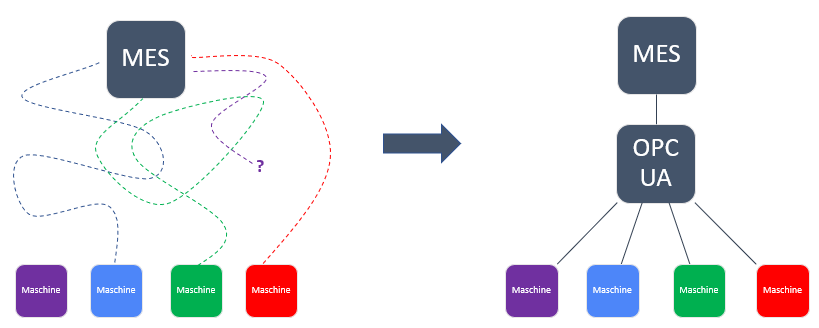Within the context of Industry 4.0, more and more companies are now recognizing just how important an MES system is for their production management.
Such software is intended to allow production processes to be planned in detail and controlled and monitored in real time. This enables a wealth of indicators to be made available to your operational production management department – providing information on the status of your production process.
The software introduction itself is a demanding project for the company – initially tying up a considerable amount of time and personnel resources. The project manager needs to consider a multitude of different topics. Even if one is aware of, or can easily identify, some of the challenges before the project kicks off, there are other problems that are not directly obvious when starting out.
For example, a new system initially means an extra burden on the employees alongside their day-to-day activities. As a rule, project staff are not released from their previous duties.
For all those affected by the reorganization, new work requirements emerge with changed job descriptions; they also have to take part in training measures – possibly being trained as multipliers etc.
Which problems, in particular, arise when introducing an MES system?
Since an MES system works with data from all the organizational layers within your company, one of the topics to which special attention is paid during the implementation phase is which data are already available. These need to be examined, evaluated, and possibly updated because incorrect data at this stage would have a direct impact on the subsequent transparency and automation of the processes in the MES system.
However, the available master data are to the most part not as complete and plausible from a quality perspective as initially assumed by the company. As a rule, it is assumed that the quality is adequate since operations are currently running smoothly on this basis. However, master data maintenance and new process descriptions then often take up more time than originally planned.
Furthermore, workflows that have developed over time generally need to be scrutinized and adapted since the factors that determined them in the past often no longer exist today. Many companies are also so deeply specialized when it comes to their individual processes and product-specific machines that it is often impossible for a general system to provide a 100 percent coverage of all the applications involved. Mapping individual processes, machine data and production scenarios digitally is not a trivial undertaking! And at the same time, it is so company-specific that the respective preparatory work can only be done by you.
Despite often being the aim of implementing an MES system: Merely purchasing software is not enough to be able to monitor your entire production cycle. The reason for this is that, alongside the time-consuming and personnel-intensive issues that arise during an MES implementation and which need to be dealt with within a pre-defined time frame, considerable technical demands are also placed on the company and its employees.
Which technical requirements need to be met?
Since the MES system will be acting as the data hub for the production department further down the line, numerous interfaces need to be managed. The software needs to be able to exchange data with the existing ERP, CAQ, PDA, MDC and time recording systems, as well as with other software products, in some cases bidirectionally.
This often means that a number of different interfaces need to be individually adapted. It is virtually impossible for an MES provider to complete this task without cooperating with the company in question due to the fact that third-party software has generally been installed to take care of this. This means that the suppliers of this software, the MES provider and your company need to closely coordinate the whole procedure.
Introducing an MES system can only be successful if the aforementioned players work together in a cooperative partnership! However, one often finds that, in practice, it is not necessarily easy to achieve such a cooperation, particularly when working on the machine interfaces. However, the reason for this is not a lack of willingness, but rather the extent of the work involved, and the specialized knowledge required to connect up the machines accordingly. Experience has shown that this component is generally greatly underestimated in the corporate project planning process.
Usually, an employee from the maintenance department or the company electrician is declared responsible for connecting up the machines. He/she is supposed to support the topic and serve as a contact person in case there are any follow-up questions. From the project management perspective, this position thus appears to have been filled by a sufficiently qualified individual. Although this employee has been well trained in his/her particular field, he/she is usually not capable of adequately meeting the demands placed on him/her.
Why is it generally impossible for the company electrician to connect up the machines?
The MES system acts as the central data hub for the production department. Each individual machine communicates with the MES system via a separate interface. So, if your company has 30 machines, 30 separate interfaces will have to be set up for them. This basically creates a separate “interface project” within the actual MES project. In comparison, the demands placed on these individual interfaces are no lower than those pertaining to the ERP, CAQ, PDA and MDC interfaces since these also require the content, protocols, and network topics to be accordingly adjusted.
As a rule, you will find that hardly any of the standards are uniform. At best, although some machine manufacturers had standards to begin with, these were rarely implemented in full in practice. The machine parks are often heterogeneous in nature – and this applies correspondingly to the machine interfaces. Quite often, the interfaces of two identical machines of the same type actually differ because, for example, a new type of controller had to be installed in each individual year of manufacture.
Generally, the company electrician has not been trained to meet such requirements. Normally, he/she is an excellent expert on the company’s own machine park when it comes to operating and servicing the machines. In some cases, he/she may even possess a knowledge of structural conversions or electrical rewiring. In most cases, however, he/she has little specialist knowledge on how to network these machines from an IT point of view – with their different interfaces, protocols, and data sets.
At some companies, employees have received additional training in PLC control systems – a great advantage when implementing an MES system. However, their in-depth knowledge is usually limited to ONE technology from ONE control system manufacturer. In Germany, we are generally talking about control systems supplied by Siemens. Frequently, however, several types of control system, such as those supplied by Heidenhain, Wago, Fanuc Mitsubishi and others, have been installed in the existing machines.
How can the machines be connected up successfully whilst savin on resources?
The fact that the MES provider will shunt the responsibility for guaranteeing the provision of the respective machine data over to you is obvious straight away. Often, it is stipulated in the contract that the data have to be provided by the customer him/herself. For the reasons mentioned earlier, however, this is not that easy for the company to achieve.
Machine connection is a seperate discipline within an MES project
Should a company wanting to implement an MES system also have to discuss shop floor interfaces with the machine manufacturers at bit and byte level, have to have these specially developed and at the end of the day have to pay for each separate service, then the effort involved will increase uncontrollably and jeopardize the success of the project. Experience has shown that many projects run much faster and more efficiently if the company and MES supplier concerned can concentrate fully on the implementation of the MES system – without having to additionally operate at machine interface level.
An OPC UA server bundles data and reduces effort
As your system integrator, we are convinced that a shop floor data hub which is subordinate to your MES system leads to some essential advantages. To this purpose, we will set up an OPC UA server for you. This will record and manage all your machine data at bit and byte level and prepare these accordingly for your MES system. From a technological and organizational viewpoint, this will take some of the burden off your MES project as only one single interface to a central OPC server then needs to be managed. On this server, all the data from each individual machine will then be immediately available in the correct format for further processing.
We will ensure that your machines are accordingly connected up to the OPC UA server – independent of your MES project team. This can even be done prior to the launch of your actual MES project, where necessary. This means that the numerous different requirements associated with connecting up your machines are simply transferred over to us, your system integrator – and we are specialized in handling a huge range of different machines. Due to having already completed numerous machine connections, we are already familiar with the data set that needs to be provided up front. This means that is often even possible to carry out the necessary work completely remotely.
Using the software products implemented by us, over 160 different machine protocols can be accordingly interpreted. The data thus gained are processed in advance and made available to the MES software via a harmonized interface. The work is done reliably in the background. Today, based on our many years of experience, we can provide plug-and-play gateways for numerous machines. These are set up in such a way as to ensure that the data are automatically generated by the machine and then forwarded to the MES system via a pre-defined interface.
For more information and an interface overview (German Website): www.madoqua-gateways.com
Jens Hopbach

Dipl.-Ing. Jens Hopbach is an electronics engineer with a BA degree in Mechatronics and a Master of Science in Electrical Engineering/Information Technology. He has gained many years of experience in the specialized areas of substitute development and IoT. At Ern & Hopbach , he is responsible for the industrial digitalization area and the development of the madoqua brand.
Christian Baczewski

Dipl.-Ing. Christian Baczewski is responsible for software development and managing international projects at Ern & Hopbach . He studied electrical engineering and has acquired many years of experience in software development in the test automation and IoT areas.

